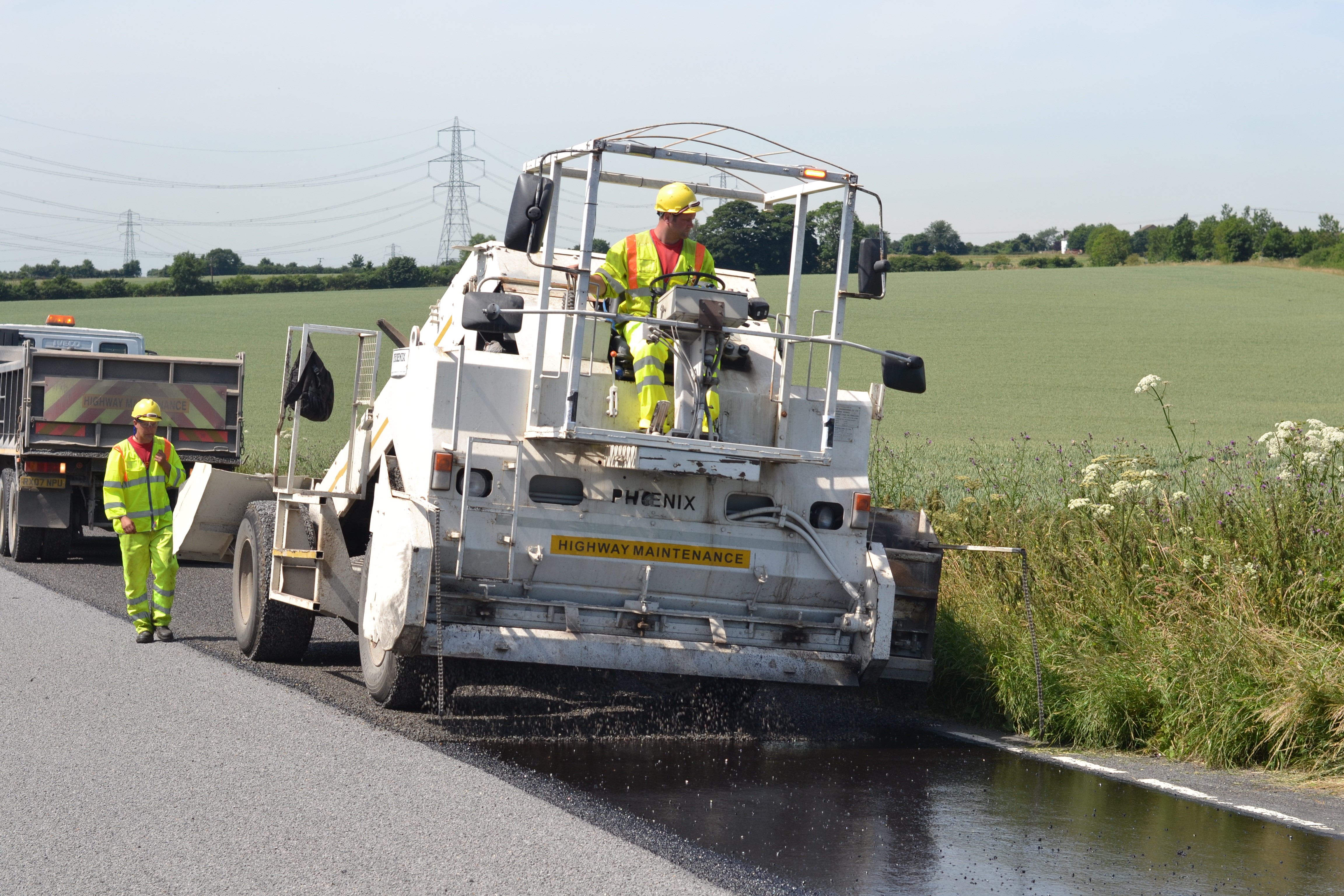The Road Surface Treatments Association (RSTA) and the Road Emulsion Association (REA) have launched a joint campaign to reverse the decade-long decline in the use of surface dressing treatments. Dominic Browne speaks to RSTA chief executive Paul Boss about making the case.
The UK Asset Management Board is currently updating Maintaining a vital asset – a kind of apolitical pamphlet, helping councillors understand the importance of good highways asset management.
It is set to be published in the autumn through the Chartered Institution of Highways and Transportation (CIHT) and the UK Roads Leadership Group and seems likely to stress the benefits of preventative maintenance treatments.
If so, it could add to a groundswell of activity boosting the case for surface dressing. Councillors are one of the key groups the RSTA and REA surface dressing campaign hopes to reach.
Mr Boss cites local politics as one of the reasons for the decline in the treatment. Experts differ on the exact figures but tend to agree that the use of surface dressing has fallen by around half since 2010 to reach around 35 to 40 million square metres a year currently.
Mr Boss (who suggests we are down to 36 million) points out that the figures should be more precise in future under Department for Transport’s (DfT) annual surveying of the sector: ‘People have been putting in surface dressing but micro surfacing and preservation have yet to be formally recorded so it is not known where these have previously been included in surface dressing or just not recorded at all. All preservative techniques have been separated now.
'The works done survey from DfT will collect the true figure for surface dressing and other treatments for each year going forward.’

While the technique sounds simple, it requires engineering knowledge and good design: ‘It needs to be right for the situation,’ Mr Boss says. On busier roads, a technique called a ‘racked in’ dressing with an enhanced binder may be used.
Mr Boss says: ‘On your racked in, you put a larger aggregate size down [10mm and above] and then a smaller aggregate and what we call “rack it in” or roll it in. The smaller aggregate will fill in between the larger aggregate, so you get better interlocking and durability, which takes a lot more traffic.
‘If you have a lot of turning movement or bends then you will probably go to a double dressing with two lots of bitumen emulsion and two lots of aggregate. You don’t want to over design, but to make surface dressing last it needs to be the right design for the traffic flows and environment, particularly commercial vehicles per lane per day; also the hardness of the road and the stresses will dictate what type of surface dressing and bitumen emulsion you will need.
'The softer the road, the more bitumen emulsion is in there, so the less new bitumen emulsion is needed. If you have a very soft road, you need a very large aggregate because you don’t want it sinking in too far.’
Road Note 39 is the design guide for surface dressing and it is also being reviewed this year. Depending on what area of the country you are in, it will even tell you when to do the work. The surface dressing season is April to September – ‘but you will only be doing 6mm single dressing in April and Sept; May to August is the main surface dressing season’ Mr Boss advises.
Between Maintaining a Vital Asset, Road Note 39, and the RSTA REA campaign, the message should be heard by councillors, officers and the public.
When done right, Mr Boss asserts, surface dressing can have tremendous results: ‘We know that for every road that is treated with surface dressing there is a saving of two-thirds of the cost on a 60-year life cycle for heavily trafficked roads and 90 years for lightly trafficked roads. We know it is saving 75% on carbon in a 60 to 90-year life cycle. Within 60-90 years, after two or three surface dressings you would normally need to replace the surface course.
‘With surface dressing you want to do your first treatment at around 10 to 15 years in the life of a road and after that it is a perpetual cycle. For a generic authority, very broadly on you’re A and B roads (we would prefer people use a hierarchy) you should be looking to surface dress around 10% of the network each year. So over 10 years you are surface dressing your whole A and B network.
'On heavily trafficked roads you have to reapply the surface dress roughly every 10 years. On your C and U roads, which are lightly trafficked, you should surface dress about every 15 years. So around 6% of C and U each year.’
So, why the decline? Well, there are several factors, including that the technique is preventative and so by definition not applied to a failing road.
Mr Boss says: ‘A really big reason [for the decline in surface dressing] is local authorities are political organisations and members want roads that are in bad condition to be replaced. If you are not being complained about and not getting that pressure, you don’t get the investment – coupled with a lack of understanding in some areas.’
This lack of understanding comes in several different forms, firstly a simple financial one. ‘Most local authorities did their surface dressing out of revenue funding. It was usually about another 50% on top of the capital monies, for surface dressing in addition to revenue money for cyclic maintenance. When the revenue monies disappeared [in austerity] the surface dressing dried up too.
This was a grey area for a while because people felt surface dressing couldn’t be done out of capital funding but CIPFA has made clear that is not an issue. You can use capital money for surface dressing. Capital monies can be used on anything that is adding value or life to the road, and as long as it will last longer than 12 months.’
However, not everyone is a fan. Full disclosure, Highways was given some constructive criticism after last month’s glowing review of the RSTA conference. A council officer said they had conducted their own cost comparison on two sections of broadly similar A road, one of which was resurfaced and the other surface dressed with an added encapsulation application. The test demonstrated a ‘marginal difference’ – around £2 a square metre.
Their central point was that cost comparisons don’t always take into account traffic management, which has the biggest impact on the value for money for the surface treatment industry. For instance, the A road this officer had surface dressed had a closure for inspection/survey, closure for road stud removal, closure for pre-patching, closure for main treatment, closure for encapsulation, closure for relining and a final closure for road stud installation/final sweeping, the officer said.
If you factor in the need to consult, back office administration, the inability to work at weather extremes and perhaps the slightly tricker calculations on design to avoid failure, the officer argues, surface dressing in comparison to resurfacing might be more complicated than first appears.
Mr Boss accepts that traffic management can add a lot to the cost of works; however ‘most traffic management is provided by the surface dressing contractor and included in the rates’.
‘It is only on major A-type roads where a third party or term maintenance contractor will be called in to provide traffic management support. This is a very small part of most programmes. For example, in Staffordshire [where Mr Boss used to work] we would apply surface dressing on around 400 sites, with around 20 of them or 5% requiring specialist traffic management.’
He adds that where traffic management is required, ‘this would normally be left on site once set up and implemented for each part of the operation where required’, except pre-patching, which should be carried out in the year before.
‘It would be rare to require a full closure for all but the main works and encapsulation. For traditional asphalt surfacing, traffic management is still required and frequently has to be put on and removed each day (or set aside on site) to enable restricted hours working and will be required for a much longer length of time. It is unusual to be able to close a main A-type road completely for several days.’
Mr Boss accepts that although the case for surface dressing is very strong it can weaken in certain circumstances, for instance where there is a lot of pre-patching (something that could be removed with a proper cycle of surface dressing) and where there are complications to a major route, such as requiring specific traffic management needs. As a guide there should be pre-patching on no more than 10% of the area to be surface dressed on an urban road or 30% on a rural road, he adds.
The final area of misconception is perhaps a legacy of earlier times. Some suggest that surface dressing is more prone to failure. Mr Boss rejects this idea: ‘The binders are much better than they were even 10 years ago. Polymer modified and enhanced binders are used extensively. It is very rare you get failures.’
He notes in conclusion that the business case for preventative treatments in general has been proven to the satisfaction of private enterprise ‘that is why privately financed operators use preservation to maintain the roads they are responsible for, e.g. M40, A50, M6 Toll’.



